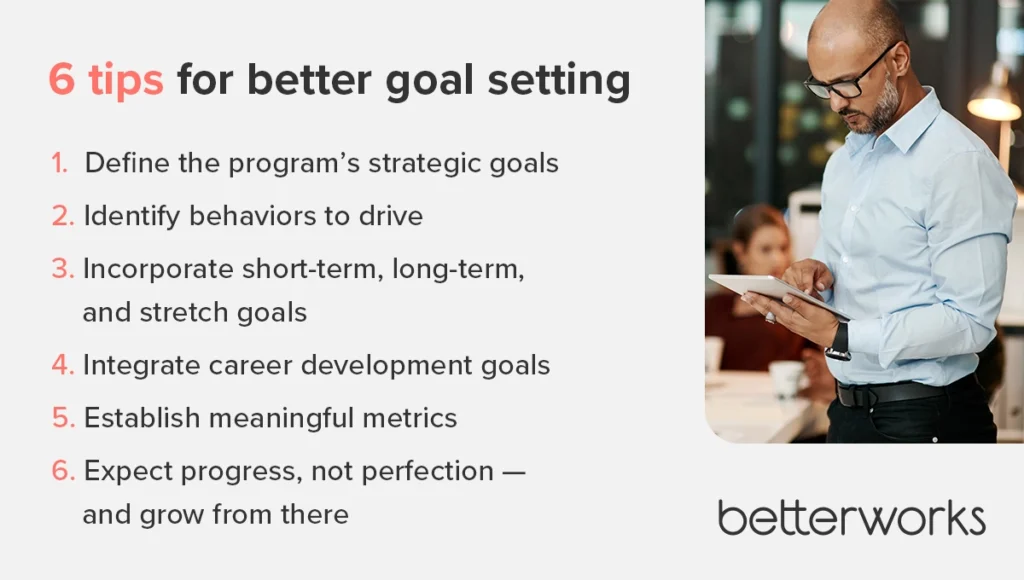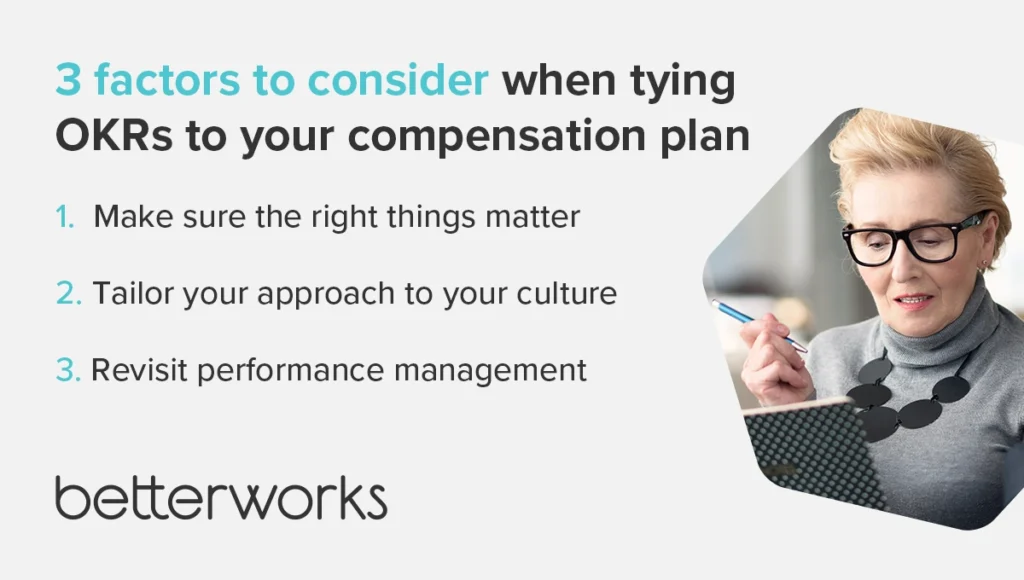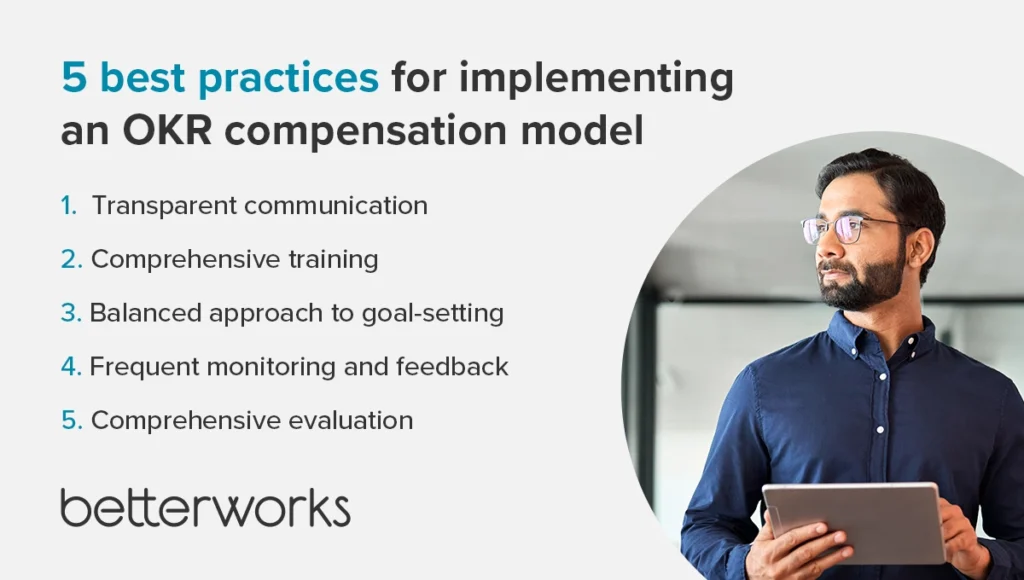Objectives and key results (OKRs) can help align employee aspirations with organizational goals by building an empowered and intrinsically motivated culture. But, when combined with extrinsic motivators — compensation and rewards — OKRs become an even more powerful tool for driving business growth. Historically, however, OKRs and compensation have been kept far apart.
That’s because the relationship between goal-setting and compensation can be complex and nuanced, with benefits and drawbacks to bringing them together. Here are some things to consider as you marry OKRs and compensation to foster a high-performance workplace where goals are met with enthusiasm — and where rewards reflect the behaviors you want.
Why link OKRs and compensation?
Tying OKRs to compensation can help align employee efforts with company goals while also promoting equity and motivating behaviors that drive success.
Aim for equity, not equality
Basing pay on OKRs can offer a more nuanced approach to fair pay — one that prioritizes equity over equality, says Caitlin Collins, organizational psychologist and program strategy director at Betterworks.
Equity involves tailoring compensation to the individual circumstances of employees, considering factors like role, market rates, performance, and contributions to the company’s goals (as reflected in OKRs). This means different employees might receive different compensation based on these factors, aiming to be fair and just according to individual contributions and circumstances.
Equality, on the other hand, means giving the same compensation to every employee regardless of their role, performance, or the market rates for their position. While this approach treats everyone the same, it might not always be fair, as it doesn’t account for individual contributions, responsibilities, or the external job market.
OKRs can help, Caitlin notes, by supporting a strategy in which compensation reflects individual and team contributions toward the company’s strategic objectives. This approach is inherently more equitable as it considers the varying degrees of impact different roles and individuals can have on achieving these goals.
Reinforce the behaviors you want to see
By linking compensation to OKRs, you can incentivize employees to prioritize and engage in behaviors and activities that align with the company’s strategic goals. This approach motivates employees to focus their efforts on high-impact activities that directly contribute to the organization’s success. Compensation becomes a clear signal of what the organization values, guiding employees toward behaviors that are rewarded.
Since OKRs often incorporate other elements of company culture — namely mission, vision, and values — tying goals to compensation also helps incentivize and reinforce value-based behaviors. Rewarding efforts to drive the company’s mission forward demonstrates that achieving the mission is a business priority, encouraging employees to focus their goals to achieve it.
3 common mistakes of tying OKRs to pay
When linking OKRs to compensation, it’s easy to fall into certain traps that can undermine your efforts. Here, we highlight some common mistakes to avoid, ensuring your strategy motivates effectively without unintended consequences.
Rewarding goals in a silo
To reward goals effectively, your goal program must be integrated seamlessly with other HR processes and programs, such as performance evaluations, learning and development opportunities, and employee recognition systems. “If your goal program is a priority for your organization for strategic reasons, it needs to reflect all your other processes,” Caitlin says. “It can’t be like a standalone program.”
By integrating your OKR and compensation practices with other organizational processes and programs, you signal that OKRs are not isolated tasks but integral components of the employee’s role and contributions to the company. This holistic approach not only enhances employee motivation and engagement but also aligns individual efforts with the business’ larger strategic objectives, thereby driving collective success.
Linking goal achievement to compensation
Only rewarding employees for achieving their goals waters down the strategic value of an OKR program. If employees are only motivated to achieve short-term results — rather than stretching themselves to learn a new skill or setting an ambitious team goal — they’re less likely to set and work toward goals that drive long-term, strategic business value.
Caitlin warns that overemphasizing results can lead to a range of negative outcomes. “It creates silos, it reduces collaboration, it reduces innovation, and it hurts organizational achievements in the long run,” she says. Rewards should also recognize the process of setting ambitious goals and the growth employees experience working toward them — not just the outcome.
Underselling the strategic value of goal-setting
When OKRs are perceived as punitive tools or means of rigid comparison, they lose their motivational power. This approach can foster a culture of fear and competition rather than one of collaboration and innovation. Employees might focus narrowly on meeting these objectives to avoid punishment or to rank favorably in comparison to their peers, which can stifle the kind of creative thinking and risk-taking that leads to genuine breakthroughs and advancement.
Furthermore, Caitlin highlights a crucial consequence of this misalignment: OKRs become disposable the moment they conflict with more immediate or pressing priorities. If employees view OKRs as burdensome tasks rather than inspirational goals that contribute to their personal growth and business success, these objectives will be the first to be sidelined when workload pressures rise.
This scenario underscores the importance of embedding OKRs within a supportive, encouraging framework that values progress and learning as much as achievement.

6 tips for better goal setting
Effective goal setting is crucial for elevating the success of your team and organization. Here are some valuable tips to enhance your approach to establishing clear, achievable, and high-impact goals.
Define the program’s strategic goals
Setting strategic goals for an OKR program starts with leaders outlining the organization’s vision. These high-level goals should be clear, motivating, and broken down into focused areas that push the organization forward.
From there, business leaders break down larger strategic goals into specific, measurable OKRs to track progress. These should be challenging but realistic, creating a clear direction. Involve teams early in defining OKRs to make sure everyone is on board and contributes to setting meaningful goals. This approach encourages ownership and motivation across the organization, turning the strategic vision into practical steps that lead to success. Betterworks 2024 State of Performance Enablement report shows that employees who feel aligned with their organization’s goals are 35% more efficient and productive than peers without goal alignment.
Identify behaviors to drive
Begin with a close examination of existing skills, mindsets, and actions within the organization to determine which ones support achieving your strategic goals. Examine your organization’s workflows, communication patterns, decision-making processes, and cultural attributes to highlight strengths and pinpoint areas needing improvement.
After pinpointing the required behaviors, the next step involves weaving these behaviors into the organization’s fabric through workplace initiatives, such as your OKR or goal-setting program.
It is crucial to clearly communicate the importance of these behaviors and their direct link to strategic goals. Rewarding and recognizing these behaviors helps underline their value and encourages their widespread adoption.
Incorporate short-term, long-term, and stretch goals
Writing OKRs effectively requires incorporating short-term, long-term, and stretch goals into your OKR program. Start by setting clear definitions for each category within the context of your organization’s timelines and aspirations.
Short-term goals should focus on immediate wins and progress checkpoints, achievable within a quarter or a few months. Team goals help keep groups motivated and on track, offering quick feedback loops for continuous improvement.
For long-term goals, look beyond the year, setting targets that align with your strategic vision and require sustained effort to achieve. These are your milestones for significant achievements and organizational growth.
Stretch goals are your ambitious targets that push the limits of what’s considered achievable. They inspire innovation and big leaps forward, though they’re not expected to be met fully. Communicate to employees that you want them to stretch themselves, and explain how rewards are allotted for setting ambitious goals.
Ideally, high-level leaders should commit to their goals by using a stretch target, such as going over a revenue target by five percent. Individual contributors should have at least one stretch goal. What’s key to remember is that having too many stretch goals can feel daunting and be disengaging. However, if an employee is always hitting 100% of their goals, they may not be challenged enough and need a stretch goal. For some roles, stretch goals may be critical to achieving ongoing innovation. Ultimately, the balance is subjective and must make sense for the person and the position.
Integrate career development goals
Encourage each team member to identify personal growth areas that support not just their career path but also the company’s strategic direction. This could involve gaining new skills, taking on leadership roles, or expanding their expertise in specific fields. Make these career goals a formal part of your OKR planning sessions.
Regularly review these career-related OKRs in performance discussions, acknowledging progress and adjusting plans as needed. By integrating career development into your OKR program, you not only foster individual growth and retention but also enhance your organization’s capability and adaptability.

Establish meaningful metrics
Choose key results that are quantifiable and directly linked to the objectives. For an employee objective like “enhance project management skills,” a key result could be “complete a certified project management course by Q3.” This method ensures goals are clear, measurable, and directly tied to development and performance improvements.
For team and business objectives, focus on outcomes that measure collective progress and impact. For a team goal of “improve customer satisfaction,” a key result could be “achieve a 15% increase in customer satisfaction survey scores within six months.” Make sure these metrics are achievable and under the team’s influence, promoting a sense of responsibility and collective effort. Review these metrics regularly to track progress, celebrate achievements, and adjust strategies as needed, keeping everyone aligned and motivated.
Expect progress, not perfection — and grow from there
When setting goals, emphasize progress over perfection. Encourage your teams to view each step forward as a success, even if it doesn’t match the initial ideal outcome. For instance, if a goal is to increase sales by 20% but you achieve a 15% increase, celebrate the progress made rather than focusing solely on the shortfall. This approach fosters a positive mindset and resilience, encouraging continuous effort and improvement.
Learning from failures is crucial. Instead of viewing them as setbacks, see them as opportunities for growth. After a goal isn’t met, gather your team to analyze what happened. Identify any obstacles encountered and discuss what could be done differently next time. Adjust future strategies based on these insights, guaranteeing that each attempt brings your team closer to its objectives. This cycle of action, reflection, and adjustment cultivates a learning culture that values development as much as achievement.

3 factors to consider when tying OKRs to your compensation plan
When you integrate OKRs into your compensation plan, you must carefully consider several critical factors to ensure alignment and motivation throughout your organization. Below, we outline the essential elements to guide you in creating a balanced, effective approach for connecting performance with rewards.
Make sure the right things matter
Link OKRs directly to the business’ strategic priorities, and tie compensation to progress made toward top business priorities. This alignment helps employees see the clear connection between their efforts, the organization’s goals, and their own compensation.
Focus on rewarding behaviors that promote collaboration, innovation, and other values important to the organization, alongside achieving specific outcomes. This approach encourages a holistic view of performance, recognizing both the results of employees’ contributions and the steps they took to get there.
Keep the linkage between goals and compensation clear and straightforward, so employees understand how their actions influence their rewards. This clarity motivates employees to engage with the OKRs actively and aligns their efforts with the organization’s strategic objectives.
Tailor your approach to your culture
First, you need to understand what drives your employees and what success looks like in your unique environment. This means setting OKRs that not only push for business growth but also resonate with the values and behaviors you want to see flourish within your teams. For instance, if collaboration is a key cultural pillar, ensure your OKRs and the related compensation incentives encourage and reward team-based achievements, not just individual performance.
Next, adapt the implementation pace and structure of your OKR program to match the readiness and characteristics of your company culture. If your organization values gradual change, introduce OKR principles and compensation ties in phases, allowing time for adjustment and buy-in. Use feedback loops to gauge how well the program is being received and make adjustments as needed.
Remember, the goal is to enhance motivation and performance by making OKRs a natural extension of your company culture, not to enforce a one-size-fits-all solution. By carefully customizing your approach, you can create a powerful synergy between OKRs, compensation, and company culture that drives sustained growth and employee engagement.
Revisit performance management
Your performance strategy informs your goal-based compensation program. In this framework, goals serve multiple purposes: they’re instruments for development, indicators for promotion eligibility, and metrics for employee evaluations.
This multifaceted approach ensures that what an employee achieves over the year not only enhances their performance in their current role but also prepares them for future responsibilities. For instance, achieving specific OKRs demonstrates an employee’s ability to deliver results and embrace the behaviors valued by the organization, making them a prime candidate for merit increases.
The link between OKR achievements and compensation becomes clear through this lens. As employees meet or surpass their goals, their contributions directly impact the company’s success, validating the rationale for merit increases. This process creates a transparent and equitable system where compensation adjustments are directly tied to individual performance and contribution, rather than being arbitrary.
By carefully mapping out how each employee’s goals contribute to their development, readiness for promotion, and justification for compensation adjustments, HR leaders can ensure that their performance strategy robustly supports the organization’s goal-based compensation program.

5 best practices for implementing an OKR compensation model
When it comes to linking OKRs and compensation, navigate the process with intention and planning. The following list of best practices will help you harness the motivational power of OKRs while mitigating risks.
Transparent communication
Explain the OKR framework and its link to compensation. Be transparent about how objectives are set, measured, and impact compensation. Use frequent communication to manage expectations, address questions, and reinforce a culture of trust and openness.
Here’s an example: To align a sales team’s goals with company objectives, leadership communicates new quarterly goals:
- Increase market penetration by 20%.
- Acquire 100 new clients.
- Boost sales by 15%.
- Achieve a customer satisfaction score of at least 85%.
Leadership should communicate that hitting these targets affects compensation — and that doing so drives the company’s overall strategy. By emphasizing a comprehensive view of performance — including the value of teamwork and innovation — you encourage a collaborative environment where everyone’s achievements are recognized and rewarded.
Comprehensive training
Provide thorough training for managers and employees on setting realistic, measurable, and achievable OKRs. This training should also cover how to track progress and evaluate outcomes. Everyone, including managers, should understand the process and how OKRs connect to compensation. This ensures the process is done correctly while improving buy-in and engagement.
Balanced approach to goal-setting
Set OKRs that balance ambitious targets with achievable goals. Employees should set goals that stretch their capabilities without leaving them demotivated by impossible expectations. Include quantitative and qualitative objectives to capture a broader range of contributions and impact.
Frequent monitoring and feedback
Implement regular check-ins between employees and managers to discuss progress toward OKRs and any adjustments needed. This ongoing dialogue supports a dynamic approach, allowing for course corrections and recognizing efforts and achievements in real time.
Comprehensive evaluation
When incorporating OKRs into compensation, consider a well-rounded assessment of employee performance that goes beyond specific key results. Recognize contributions toward personal growth, teamwork, creativity, and impact on company culture. A thorough evaluation ensures that compensation accurately reflects an employee’s true value within the organization.

Take a thoughtful approach to linking OKRs and compensation
By thoughtfully integrating OKRs with rewards systems, companies can incentivize employees, align individual efforts with organizational goals, and ensure a fair and transparent approach to compensation. This strategy promotes a culture of achievement and continuous improvement while laying the foundation for equitable and performance-driven reward systems.
However, HR leaders must implement this approach with a nuanced understanding and a robust framework that mitigates potential drawbacks. A careful, intentional approach to tying OKRs to pay empowers you to create an environment where the rewards system truly reflects your organization’s achievements and values.
Want to learn more? Find out how to use OKRs to become a great manager.
Help managers improvise by using OKRs





